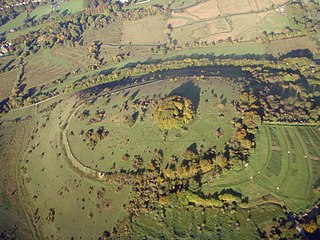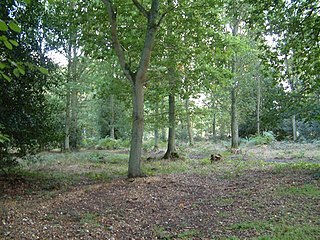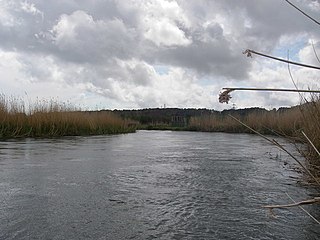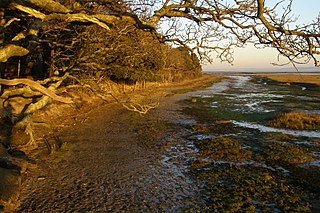
Hampshire and Isle of Wight Wildlife Trust is a Wildlife Trust with 27,000 members across the counties of Hampshire and the Isle of Wight, England.

Noar Hill is a 63-hectare (160-acre) biological Site of Special Scientific Interest south of Selborne in Hampshire. It is a Nature Conservation Review site, Grade 2, and part of East Hampshire Hangers Special Area of Conservation. An area of 20 hectares is a nature reserve managed by the Hampshire and Isle of Wight Wildlife Trust.

Arreton Down is a 29.77 hectare biological Site of Special Scientific Interest on the Isle of Wight, originally notified in 1979 for its geological interest and then renotified in 1987, but for its biological interest only. It is public access land and popular with early morning dog walkers, who park near the chalk pit entrance. The land is marked by extensive ancient field features as yet unexcavated.

St. Catherine's Hill is a chalk downland hill and 43-hectare (110-acre) biological Site of Special Scientific Interest on the outskirts of Winchester in Hampshire. It is owned by Winchester College but open to the public. It is managed by Hampshire and Isle of Wight Wildlife Trust, and most of it is an Iron Age hillfort, which is a Scheduled Monument.

Pamber Forest and Silchester Common is a 341.7-hectare (844-acre) biological Site of Special Scientific Interest in Tadley in Hampshire. Pamber Forest and Upper Inhams Copse is managed by the Hampshire and Isle of Wight Wildlife Trust and Pamber Forest is a Local Nature Reserve.

Avon Valley (Bickton to Christchurch) is a 1,403.8-hectare (3,469-acre) biological Site of Special Scientific Interest which stretches from Christchurch in Dorset to Bickton, south of Fordingbridge Hampshire. It is a Nature Conservation Review site, a Ramsar site, a Special Area of Conservation and a Special Protection Area. An area of 159 hectares (390 acres) is Blashford Lakes, a nature reserve managed by the Hampshire and Isle of Wight Wildlife Trust,

Emer Bog and Baddesley Common is a 50-hectare (120-acre) nature reserve north of North Baddesley in Hampshire. It is managed by the Hampshire and Isle of Wight Wildlife Trust. An area of 39.0 hectares is designated as Baddesley Common biological Site of Special Scientific Interest. An area of 37.6 hectares is designated Emer Bog Special Area of Conservation

Coulters Dean is a 2.2-hectare (5.4-acre) biological Site of Special Scientific Interest south-east of Buriton in Hampshire. It is part of the 4-hectare (9.9-acre) Coulters Dean nature reserve, which is managed by the Hampshire and Isle of Wight Wildlife Trust.

Foxlease and Ancells Meadows is a 68.8-hectare (170-acre) biological Site of Special Scientific Interest on the western outskirts of Farnborough in Hampshire.The site is in seven areas, two of which are nature reserves managed by the Hampshire and Isle of Wight Wildlife Trust, Ancells Farm and Whitehouse Meadow.

Greywell Fen is a 38-hectare (94-acre) biological Site of Special Scientific Interest in Greywell in Hampshire. It is a Nature Conservation Review site, Grade 2, and an area of 13 hectares is a nature reserve called Greywell Moors, which is managed by the Hampshire and Isle of Wight Wildlife Trust.

Hook Common and Bartley Heath is a 129.4-hectare (320-acre) biological Site of Special Scientific Interest on the southern outskirts of Hook in Hampshire, England. It is managed by the Hampshire and Isle of Wight Wildlife Trust.

Lower Test Valley is a 142-hectare (350-acre) biological Site of Special Scientific Interest near Totton in Hampshire. It is part of Solent and Southampton Water Ramsar site and Special Protection Area, and of Solent Maritime Special Area of Conservation. It is a nature reserve managed by the Hampshire and Isle of Wight Wildlife Trust.

Lymington River Reedbeds is a 41.7-hectare (103-acre) biological Site of Special Scientific Interest in Lymington in Hampshire. It is a nature reserve managed by the Hampshire and Isle of Wight Wildlife Trust. It is part of Solent and Southampton Water Ramsar site and Special Protection Area.

Roydon Woods is a 294.9-hectare (729-acre) biological Site of Special Scientific Interest near Brockenhurst in Hampshire. It is a nature reserve managed by the Hampshire and Isle of Wight Wildlife Trust and is part of New Forest Special Area of Conservation.

Warnborough Green is a 4.4-hectare (11-acre) biological Site of Special Scientific Interest in North Warnborough in Hampshire. It is owned and managed by the Hampshire and Isle of Wight Wildlife Trust.

Boldre Foreshore is a 193.3-hectare (478-acre) Local Nature Reserve east of Lymington in Hampshire. It is owned by New Forest District Council and managed by the Hampshire and Isle of Wight Wildlife Trust. It is part of Solent and Southampton Water Ramsar site and Special Protection Area, Solent Maritime Special Area of Conservation, Hurst Castle and Lymington River Estuary Site of Special Scientific Interest and Lymington and Keyhaven Marshes, a nature reserve managed by the Hampshire and Isle of Wight Wildlife Trust.

Ancells Farm is a 12-hectare (30-acre) nature reserve in Fleet in Hampshire. It is managed by the Hampshire and Isle of Wight Wildlife Trust. It is part of Foxlease and Ancells Meadows, which is a Site of Special Scientific Interest.

Hockley Meadows is a 9-hectare (22-acre) nature reserve south of Winchester in Hampshire. It is managed by the Hampshire and Isle of Wight Wildlife Trust. It is part of the River Itchen SSSI and Special Area of Conservation.


















